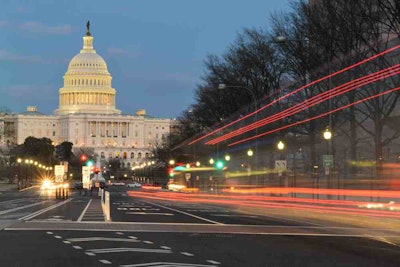
The future of a long-term transportation bill became a bit brighter after Sens. Mitch McConnell (R-Kentucky) and Barbara Boxer (D-California) announced they had agreed in principle to a bipartisan a six-year transportation bill that aims to provide the Highway Trust Fund (HTF) with guaranteed funding for three years.
However, in awkward procedural efforts, a vote on the 1,030-page H.R. 22 (DRIVE Act) will be delayed to allow members of the Senate more time to review the details. Yesterday afternoon, a scant couple of hours after receiving the text of the bill, the Senate voted 56 to 41 against the motion to invoke cloture on the motions to proceed.
“We need the opportunity to look at this bill,” Sen. Harry Reid (D-Nevada) said after the cloture vote. “We just want to be able to read and discuss this bill tomorrow in a private meeting.” Reid added that he wants to do everything he can to move forward on a long-term bill, but that the Senate was “not going to lurch into legislation without reading it in detail.” Reid also said he wants to get reports from the committees of jurisdiction, such as commerce and banking.
“That fact that it hasn’t been online long is a good point,” McConnell said. But, the Senate Majority Leader threatened a weekend vote on the matter to get it through. “Imagine getting a bill . . . to the president’s desk before August. That’s something we could all be proud of. We need to keep at it.”
“We have an agreement in principle,” Boxer had said of the agreement. “I believe it’s a breakthrough. I’ve been negotiating in good faith . . . for a long-term, robust bill.”
The full bill is available here.
Members of the House passed a six-month for the HTF last week, a measure that would provide $8 billion, which would last until Dec. 18. If it continues on through the Senate and is signed by President Obama it would represent the 34th time a short-term patch has been issue since 2008.
Below is a lengthy summary from the Senate Environment & Public Works Committee:
The DRIVE Act builds on the success of the comprehensive reforms and performance-based approach to transportation investment included in the 2012 Moving Ahead for Progress in the 21st Century Act (MAP-21). It provides six years of increased funding, giving state and local governments the certainty and stability they need to improve and develop our nation’s transportation infrastructure. These investments will create new jobs, provide a sustained boost to our nation’s economy, and keep America competitive in the global marketplace.
TITLE I:
- Supports core formula programs: The DRIVE Act reauthorizes the federal aid highway program, maintains formula program structure and increases the amounts each state will receive each fiscal year.
- Prioritizes bridges and large facilities of national importance: The DRIVE Act increases the funding to maintain bridges of national importance and shifts additional revenue towards the Interstate System and the National Highway System.
- Dedicates funding for freight programs: The DRIVE Act establishes a formula-based freight program and expands flexibility for both rural and urban areas to designate key freight corridors that match regional goods movement on roads beyond the Primary Highway Freight System.
- Provides assistance for major projects: The DRIVE Act provides funds for major projects of high importance to a community, region, or the nation through a competitive grant program.
- Extends new user fee to electric vehicles: The DRIVE Act ensures all users of the roads and bridges pay their fair share with a new federal share program initializing new state controlled user fees.
- Funds rural land, federal lands and tribal projects program: The DRIVE Act empowers states to work with the Department of Transportation to develop ways to effectively utilize flexibilities for small projects, with new options to bundle rural road and bridge projects to increase efficiencies and better respond to community needs. The bill also authorizes funds for nationally significant federal lands and tribal transportation projects.
- Streamlines the environmental review process: To make the NEPA process more efficient, the legislation cuts red tape and streamlines project delivery while improving collaboration between federal agencies.
TITLE II:
- Supports transportation research: The DRIVE Act advances education and welcomes innovation by requiring at least half of the grants in the Technology and Innovation Development Program to be distributed to outside entities. By focusing the research program on deployment and innovation, the DRIVE Act ensures that states and local governments will receive the most usable research products that will facilitate cost-effective and efficient project delivery in the future.
- Enforces transparency: The DRIVE Act includes new provisions to improve the transparency of how and where transportation projects are selected and funded, to ensure that stakeholders and the public have faith in the integrity of highway programs and the use of federal tax dollars. The legislation also ensures public accountability on Federal Highway Administration administrative expenses as well as progress towards achieving national goals and improving federal reviews of highway projects.
TITLE III:
- Improves TIFIA program: The DRIVE Act updates the Transportation Infrastructure Finance and Innovation Act (TIFIA) program and provides state and local governments new options for stretching transportation dollars and increasing efficiency and utilization. It also improves the process whereby a TIFIA loan can be used to capitalize a State Infrastructure Bank, providing increased leverage for small, rural projects that was previously unavailable.
Safety/Regulatory (Commerce Committee):
The bill’s safety and regulatory title make important enhancements for safer highways as well as freight and passenger rail service through effective implementation of new technologies, new tools for federal safety watchdog agencies, reforming grant programs for states, and transparency that promotes accountability.
- Railroad Safety – The bipartisan Railroad Reform Enhancement and Efficiency Act introduced by Sen. Roger Wicker (R-Miss.) and Sen. Cory Booker (D-N.J.) increases safety, improves infrastructure, facilitates the implementation of new technology, and cuts red tape.
- Auto Safety – Reforms focus on fixing both systemic problems at the federal government’s troubled auto safety regulator by requiring the Secretary of Transportation to certify that fundamental reforms have occurred before any additional funding is authorized and providing new targeted authorities to protect the traveling public, increase consumer awareness, and hold the auto industry accountable for safety violations.
- Reforming Grants and Project Permitting – Building on the Obama Administration’s proposed GROW AMERICA Act, the bill provides additional authority to streamline the delivery of infrastructure projects, consolidates state trucking enforcement grants to provide additional flexibility to states, and helps each state address unique safety and multimodal challenges for highways, railroads, ports, airports, and pipelines.
Public Transit (Banking Committee):
- Increases public transportation funding nearly $2 billion over MAP-21 levels.
- Restores more than $387 million to the Bus and Bus Facilities Program to bring the total program level back up to $815 million by fiscal year 2021. This increase includes the reinstatement of a bus discretionary program totaling $190 million per year to address the capital investment needs of transit systems across the country.
- Provides an additional $862 million for Urbanized Area Formula grants to meet the increasing demands of public transportation systems across the country.
- Includes a 7.5 percent increase, or $162 million, in fiscal year 2016 to allow public transportation agencies with rail fixed guideway systems to continue to address their most pressing state of good repair needs. The total program grows an additional $292 million over the remainder of the authorization period.
- Streamlines the Capital Investment Grant program for projects employing innovative project delivery and financing methods by creating a new, expedited project delivery program for projects seeking minimal federal funding.
- Increases funding for rural areas by $105 million, including additional funding for Public Transportation on Indian Reservations.
- Includes a dedicated program for the procurement of innovative vehicles and innovative vehicle technology for use in public transportation.
- Commits $4 million annually to address training deficiencies and workforce shortages impacting the public transportation industry.
- Incentivizes innovative procurement methods for the purchase of public transportation vehicles by enabling state purchasing schedules, non-profit cooperative procurement programs, and new leasing options.
- Grants the Federal Transit Administration the authority to set minimum safety standards to ensure the safe operation of public transportation systems.
- Permits revenue generated from value capture financing to be counted towards the local share of a project cost.
Federal Permitting Reform (Homeland Security/Governmental Affairs):
The Federal Permitting Improvement Act, which is included in the DRIVE Act, is modeled on the commonsense, bipartisan permit-streamlining reforms of the 2006 and 2012 transportation bills, recommendations from the President’s Jobs Council, and other recent studies on this issue. The bill would improve the permitting process for major capital projects in three ways: better coordination and deadline-setting for permitting decisions; enhanced transparency; and reduced litigation delays. The bill is limited to economically significant capital projects, defined based on the size of the total investment (more than $200 million), or other projects likely to benefit from increased agency coordination. It covers major capital projects across sectors, including renewable or conventional energy production, electricity transmission, surface transportation, aviation, ports and waterways, water resources, broadband, pipelines, and manufacturing.
Funding Sources:
The bill is fully offset with spending reductions or changes in federal programs. It does not increase the deficit or raise taxes.
The funding comes from a long list of offsets and tax compliance strategies included below.
Highway bill – Finance Division Summary
EXTENSIONS
- Extension of Trust Fund Expenditure Authority and Related Taxes. Extends authority to spend from the Surface Transportation trust fund, the Sportfish Restoration and Boating trust fund, and the Leaking Underground Storage Tank trust fund through October 1, 2021. Extends related tax authorities through October 1, 2023.
- General fund transfers. Transfers savings obtained from the bill’s offsets into the Surface Transportation trust fund.
- Deposit Motor Vehicle Penalties in the Highway Trust Fund. The provision would deposit the civil penalties related to motor vehicle safety in the highway trust fund instead of in the Treasury’s General Fund. Offset estimate: $350 million
TAX COMPLIANCE
- Modification of mortgage information reporting requirements. Current law requires lenders to provide the IRS with each borrower’s name, address, and taxpayer identification number, as well as the amount of interest paid in a given year (including discount points) on a mortgage. This provision would require lenders to also provide the origination date of the mortgage, the amount of outstanding principal at the end of a calendar year, and the property’s address – all of which would help reduce inaccurate reporting. The provision would apply to returns and statements the due date for which (determined without regard to extensions) is after December 31, 2016, and is estimated to raise $1.806 billion over 10 years.
- Require consistency between estate tax value and income tax basis of assets acquired from a decedent. Many years after inheriting property, beneficiaries can overstate the value of a piece of property at the date of inheritance on their income tax returns and, as a result, understate their income tax liability on profits made when they sell it. This provision would require those estates with positive estate tax liability to provide the IRS the value of a piece of property upon the owner’s death. The provision would apply to transfers for which an estate tax return is filed after the date of enactment, and is estimated to raise $1.542 billion over 10 years.
- Clarify the 6-year statute of limitations in the case of overstatement of basis. Current law gives the IRS six years to reassess taxpayers who substantially understate income (by 25 percent or more). The Supreme Court ruled that this statute does not apply in cases where taxpayers misrepresent the “basis” (or original cost) of a piece of property and, as a result, substantially understate their tax liability when they sell it. This provision would make the intent of the law clear and affirm that the six-year rule also applies in cases where any overstatement of basis results in a substantial omission of income. The provision would apply to returns filed after the date of enactment as well as to returns filed on or before the date of enactment if the assessment period is still open with respect to those returns as of the date of enactment, and is estimated to raise $1.206 billion over 10 years.
- Change the filing due dates of certain tax and information returns. These provisions would modify the rules on tax return-filing deadlines for partnerships, S corporations, and C corporations. Such modifications would provide for a better flow of required tax return information between entities and those who invest in them, allowing for improved compliance by taxpayers, improved accuracy of tax and information returns, and a reduced number of amended returns. In general, these provisions would apply to returns for taxable years beginning after December 31, 2015, and are estimated to raise $0.285 billion over 10 years.
- Revocation or denial of passport in case of certain unpaid taxes. This provision would authorize the Federal government to deny the application for a passport when an individual has more than $50,000 (indexed for inflation) of unpaid federal taxes which the IRS is collecting through enforcement action. It would also permit the Federal government to revoke a passport for such individuals. Before revocation, however, the Federal government would be allowed to limit a previously issued passport only for return travel to the United States or to issue a limited passport that only permits return travel to the United States. The provision would be effective on January 1, 2016, and is estimated to raise $0.398 billion over 10 years.
- Reform of rules related to qualified tax collection contracts. These provisions would require the federal government to use private debt collection agencies to help facilitate the collection of taxes owed the government. The provisions incorporate safeguards such as narrowing the class of receivables subject to collection and giving priority to previously approved contractors to protect taxpayer rights and privacy. The provisions would generally be effective upon date of enactment and are estimated to raise $2.384 billion over 10 years.
- Allow employers to transfer excess defined-benefit-plan assets to retiree medical accounts and group-term life insurance. The Highway, Investment, Job Creation, and Economic Growth Act of 2012 (MAP-21) gave employers this option through the end of 2021. This provision would extend the rule through the end of 2025. Offset estimate: $172 million.
FEES & RECEIPTS
- Extend deposits of TSA (security service) fees in the general fund. Current law mandates that certain TSA fees be deposited in the general fund through 2024. This provision merely extends the deposits of TSA fees into the general fund by two years, pulling more funds into the 10-year window. Offset estimate: $3.5 billion.
- Index customs user fees to inflation. Customs user fees are collected by the U.S. Customs service to offset inspection costs. The proposal would index the fees to inflation, so the real cost of the fees would remain the same over time, instead of decreasing as inflation diminished the value of the fees. Offset estimate: $4.0 billion.
- Change the fixed dividend rate paid by the Federal. The fixed 6.0% interest rate in current law was put in place in the 1930s, in part to assure that the Federal Reserve System gained bank membership. That assurance is no longer necessary. The overly generous 6.0% rate will be reduced to 1.5% for large banks (over $1 billion in consolidated assets) and maintained at 6.0% for banks under that threshold. Offset estimate: $16.3 billion.
- Provide for drawdown and sale of crude oil from the Strategic Petroleum Reserve (SPR). The SPR has a 727 million barrel capacity; as of June 26, 2015, it held 693.7 million barrels. This provision, with emergency protection, calls for the Secretary of Energy to draw down and sell 101 million barrels of crude oil from the SPR over the period of fiscal years 2018 through 2025. Offset estimate: $9.0 billion.
- Extend the expiration date for enterprise guarantee fees. As compensation for providing a guarantee on repayment of the mortgages underlying mortgage-backed securities, Fannie Mae and Freddie Mac charge mortgage lenders guarantee fees. These fees are set to decline by 10 basis points (a basis point is one hundredth of one percent) at the end of 2021. This provision would extend the current level of fees through 2025. The regulator for Fannie Mae and Freddie Mac recently completed a review of the guarantee fees and found “no compelling economic reason to change the general level of fees” which are continued by this provision. Offset estimate: $1.9 billion.
OUTLAYS
- Rescind unused TARP funds (funds that have not been committed in contracts) for the Hardest Hit Fund program. Since its inception, the HHF has been criticized by the Special Inspector General for TARP as being ineffective, without objectives, and poorly administered. House prices have sufficiently recovered, and foreclosure activities have sufficiently abated, so that funds in this would be better put to use for Americans in infrastructure investments. Offset estimate: $1.7 billion.
- Strike the requirement that the Office of National Resources Revenue (ONRR) pay interest on overpayments. ONRR, which is part of the Department of the Interior, believes that some lessees overpay deliberately in order to engage in “banking with ONRR” and that the ONRR interest rate is in some cases greater than that offered by other interest earning mechanisms. This provision is part of the President’s FY 2016 budget. Offset estimate: $300 million.
- Amend the Social Security Act to make certain revisions to provisions limiting payment of benefits to fugitive felons. Current law allows Social Security benefits to be paid to people with felony warrants. This provision extends the limitations to include those who are subjects of a felony arrest warrant and for whom the state has given notice that they intend to pursue the warrant. The provision also includes a safeguard that allows the Commissioner of Social Security to allow payments to such individuals for “good cause.” Offset estimate: $2.3 billion.












